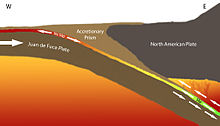User:Eround1/FirstDraft
This page is currently being created as a class project at LSU. Please do not edit.
Slow Earthquake[edit]
| Part of a series on |
| Earthquakes |
|---|
 |
A slow earthquake is a discontinuous, earthquake-like event that releases energy over a period of hours to months, rather than the seconds to minutes characteristic of a typical earthquake. First detected using long term strain measurements,[1] most slow earthquakes now appear to be accompanied by fluid flow and related tremor,[2] which can be detected and approximately located using seismometer data filtered appropriately (typically in the 1–5 Hz band). That is, they are quiet compared to a regular earthquake, but not "silent" as described in the past.[3] They rupture anywhere between 1 to 1.5 kilometres (0.62 to 0.93 mi) per second as compared to 3 kilometres (1.9 mi) per second for regular earthquakes.[4] They are also capable of causing enormous tsunamis and damage to cities, just like regular earthquakes.[4]
Causes[edit]

Earthquakes occur as a consequence of a gradual stress increases in a region, and once it reaches the maximum stress that the rocks can withstand a rupture generates and the resulting earthquake motion is related to a drop in the shear stress of the system. Earthquakes generate seismic waves when the rupture in the system occurs, the seismic waves consist of different types of waves that are capable of moving through the Earth like ripples over water. [5] The causes that lead to slow earthquakes have only been theoretically investigated, by the formation of longitudinal shear cracks that were analysed using mathematical models. The different distributions of initial stress, sliding frictional stress, and specific fracture energy are all taken into account. If the initial stress minus the sliding frictional stress (with respect to the initial crack) is low, and the specific fracture energy or the strength of the crustal material (relative to the amount of stress) is high then slow earthquakes will occur regularly.[6]
In other words, slow earthquakes are caused by a variety of stick-slip and creep processes intermediated between asperity-controlled brittle and ductile fracture. [citation needed] Asperities are tiny bumps and protrusions along the faces of fractures. They are best documented from intermediate crustal levels of certain subduction zones (especially those that dip shallowly — SW Japan, Cascadia[7], Chile), but appear to occur on other types of faults as well, notably strike-slip plate boundaries such as the San Andreas fault and "mega-landslide" normal faults on the flanks of volcanos.[7]
Locations[edit]

There is faulting all over Earth, some of these faults can be convergent, divergent, and transform faults, and are normally located on plate margins. Some of the locations that have been recently studied for slow earthquakes are, Cascadia [7], California, Japan, New Zealand, Mexico, and Alaska. The locations of slow earthquakes can provide new insights into the behavior of normal or fast earthquakes. With the help of slow-slip and slow earthquakes, we can use the location of tremors associated with these to determine the extension of the system and estimate future earthquakes in the area of study.[5]
Episodic Tremor and Slip[edit]

Slow earthquakes can be episodic (relative of plate movement), and therefore somewhat predictable, a phenomenon termed episodic tremor and slip or ETS in the literature. ETS can last for weeks as opposed to "normal earthquakes" that are over before they even begin. Several slow earthquake events around the world appear to have triggered major, damaging seismic earthquakes in the shallower crust (e.g., 2001 Nisqually, 1995 Antofagasta). Conversely, major earthquakes trigger "post-seismic creep" in the deeper crust and mantle.[8] Just like regular earthquakes, slow earthquakes can give way to the creation of devastating tsunamis. One of the last deadly tsunami was the Mentawai tsunami. The earthquake that caused this registered a magnitude of 7.8 that struck offshore the Mentawai islands in western Indonesia that caused more than 400 human casualties.[9] This was characterized as a slow earthquake due to disproportionately large tsunami waves, rupture duration near 125 seconds, shallow near trench slip, and deficiencies in energy.
References[edit]
- ^ Michael R. Forrest. "Slow Earthquakes". Scec.org. Retrieved 2010-05-05.
- ^ Brown, Kevin M.; Tryon, Michael D.; DeShon, Heather R.; Dorman, LeRoy M.; Schwartz, Susan Y. (2005). "Correlated transient fluid pulsing and seismic tremor in the Costa Rica subduction zone" (PDF). Earth and Planetary Science Letters. 238 (1–2). Elsevier: 189–203. Bibcode:2005E&PSL.238..189B. doi:10.1016/j.epsl.2005.06.055.
- ^ Timothy I. Melbourne and Frank H. Webb (2003-06-20). "GEOPHYSICS: Enhanced: Slow But Not Quite Silent - Melbourne and Webb 300 (5627): 1886 - Science". Sciencemag.org. doi:10.1126/science.1086163. PMID 12817131. Retrieved 2010-05-05.
{{cite journal}}: Cite journal requires|journal=(help) - ^ a b Mustain, Andrea (2011-03-18). "Sneaky 'Slow' Earthquakes Can Cause Outsize Tsunamis". LiveScience & UurAmazingPlanet. Retrieved 2011-03-26.
{{cite web}}: Unknown parameter|month=ignored (help) - ^ a b Aida Quezada-Reyes. "Slow Earthquakes: an Overview" (PDF).
- ^ Teruo Yamashita (1980). "Causes of Slow Earthquakes and Multiple Earthquakes - Teruo Yamashita". Journal of Physics of the Earth.
- ^ a b c Walter Szeliga, Timothy I. Melbourne, M. Meghan Miller, and V. Marcelo Santillan (2004). "Southern Cascadia episodic slow earthquakes" (PDF). Geophysical Research Letters.
{{cite web}}: CS1 maint: multiple names: authors list (link) - ^ Timothy I. Melbourne and Frank H. Webb. "Surface Creep Measurements from a Slow Earthquake on the San Andreas Fault Using InSAR". Seismo.berkeley.edu. Retrieved 2010-05-05.
- ^ Andrew V. Newman, Gavin Hayes, Yong Wei, and Jaime Convers (2011). "The 25 October 2010 Mentawai tsunami earthquake, from real-time discriminants, finite-fault rupture, and tsunami excitation" (PDF). Geophysical Research Letters. Retrieved 2012-10-16.
{{cite web}}: CS1 maint: multiple names: authors list (link)
